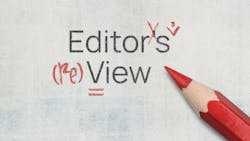Editor’s (re)View: Trump, The Art of the Deal, and pharmaceutical tariffs
Not surprisingly, President Donald Trump this week made his most outlandish tariff threat to date, telling CNBC on Tuesday that levies on pharmaceutical imports could reach 250%. It’s the highest tariff rate Trump has threatened so far on the sector.
“We’ll be putting an initially small tariff on pharmaceuticals but in one year — one and a half years maximum — it’s gonna go to 150% and then it’s gonna go to 250%, because we want pharmaceuticals made in our country,” Trump told CNBC.
It was a significant increase from last month when Trump threatened to impose a 200% pharma-specific tariff, as part of his strategy to pressure drugmakers to increase domestic manufacturing and move their operations to the U.S. At the time, William Blair analyst Max Smock called it “absurd” and a much higher than expected rate. The silver lining, Smock said, was a year-and-a-half grace period giving pharma companies time to “adjust” rather than imposing tariffs immediately.
However, drugmakers and contract manufacturers have recently downplayed the impact of tariffs. AstraZeneca last week said it will not be significantly impacted by tariffs, while Eli Lilly this week said it expects a “modest” 2025 impact from currently announced tariffs.
“I can’t tell you how many texts and emails I get about tariffs and policy happening in Washington,” Paul Josephs, CEO of Minnesota-based contract manufacturer Lifecore Biomedical, told analysts on Thursday. “Personally, I consider that just noise. I don’t think anybody in the industry really believes that we’ll have tariffs at the 250% level.”
Nonetheless, since the start of his second term, Trump has doubled, tripled, and quadrupled down on his threat to target the pharmaceutical industry with tariffs, which are meant to secure U.S. drug supply chains by onshoring production and create manufacturing jobs in this country.
Clearly, Big Pharma companies have responded in droves with major U.S. investment announcements, most notably Johnson & Johnson’s $55 billion commitment and respective pledges of $50 billion each from AstraZeneca and Roche. Still, it doesn’t seem like it’s enough to satisfy Trump.
Trump’s supporters insist that there’s a method behind his policy madness when it comes to his incessant tariff threats and shifting deadlines, which they contend have forced countries to come to the negotiating table and will ultimately result in favorable trade deals — such as the 15% tariff rate imposed under a U.S.-EU agreement announced last week.
In his 1987 book, The Art of the Deal with journalist Tony Schwartz, Trump wrote that his style of dealmaking is simple and straightforward: he aims “very high” and keeps “pushing and pushing” to get what he’s after. “Sometimes I settle for less than I sought, but in most cases, I still end up with what I want.”
That seems to be Trump’s tariff playbook when it comes to pharmaceuticals. Threaten outrageously high industry-specific tariffs and drugmakers will come running back to this country. Trump in March threatened to levy a 25% across-the-board tariff on foreign-made drugs, and now it’s up to 250%. What’s next 300%?
The results of the Trump administration’s Section 232 investigation into the U.S. national security implications of pharmaceutical imports are expected in the next week or so, with its recommendations on tariffs. Who’s ready to make a deal?
About the Author
Greg Slabodkin
Editor in Chief
As Editor in Chief, Greg oversees all aspects of planning, managing and producing the content for Pharma Manufacturing’s print magazines, website, digital products, and in-person events, as well as the daily operations of its editorial team.
For more than 20 years, Greg has covered the healthcare, life sciences, and medical device industries for several trade publications. He is the recipient of a Post-Newsweek Business Information Editorial Excellence Award for his news reporting and a Gold Award for Best Case Study from the American Society of Healthcare Publication Editors. In addition, Greg is a Healthcare Fellow from the Society for Advancing Business Editing and Writing.
When not covering the pharma manufacturing industry, he is an avid Buffalo Bills football fan, likes to kayak and plays guitar.
